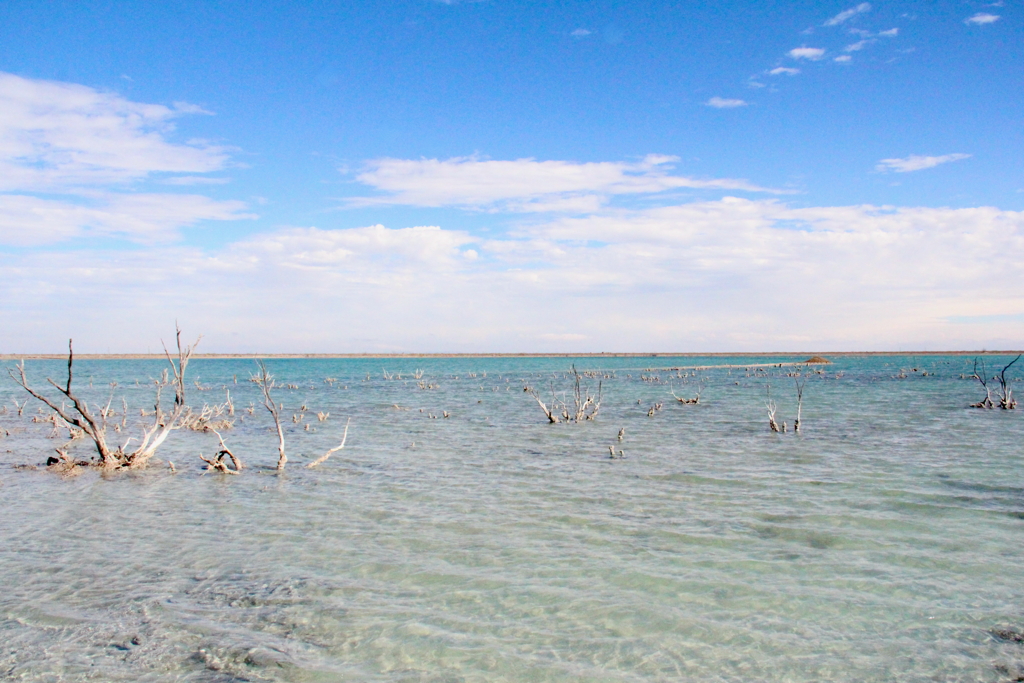A vast body of toxic well water has bubbled out of the ground near Imperial, Texas for nearly two decades.
Imperial is in an arid part of Texas, about 50 miles southwest of Odessa. The water – called ‘Lake Boehmer’ in honor of the property’s last known owner – comes up from a set of abandoned oil wells. The lake has grown over the years. Now, it covers more than sixty acres.
Russell Gold, a senior editor for Texas Monthly, recently wrote about the lake. He talked to Texas Standard about his visit there, and the lack of regulatory response. Listen to the interview above or read the transcript below.
This transcript has been edited lightly for clarity:
Texas Standard: What’s the story here? Where’s this water coming from?
Russell Gold: Well, the water’s coming from an old abandoned well that’s pretty much right in the middle of the lake. You can actually kind of walk out on a jetty and see it, and it’s just sitting there flowing off about 200 gallons a minute. This was a well that was drilled in in the 1950s by an oil company in search of oil, and it was dry. And so the oil company turned to the landowner and said, ‘hey, do you want a nice deep well that you can use to irrigate?’ And for as far as we can tell, for years it flowed reasonably decent water. But then at some point the casing started to corrode. The well went bad and it got really salty. It hit a salt layer. And now, Lake Boehmer, as it’s called, is about three times as the Gulf of Mexico. It looks inviting, but you wouldn’t want to get in it. It’s got hydrogen sulfide. It smells. It’s a real mess out there.
What you’re describing reminds me a lot of the stories I’ve heard about the Salton Sea in Southern California, where you had a similar sort of diversion of water and it’s incredibly salty. Can you describe to us what this looks like? How big are we talking about?
Yeah, I’ve been out there. It’s about 60 acres. It’s a nice sized lake. You’re right in the middle of sort of the West Texas flat desert and you come upon it and it’s quite beautiful because it’s so salty and it’s got other toxic elements.
All of the vegetation near it and some that even grew up out of it before there was a lake is sort of dead and denuded. But other than that, when I was out there, there was a flock of ducks that saw it as inviting and circled around and landed on it. It’s quite pleasant to look at. It’s just a toxic mess. And frankly, someone needs to step up and do something about it.
That’s the question, right? How has this gone on for so long and no one’s done anything about it? What about property owners regulators?
As far as we can tell from the satellite images, the lake has been slowly growing since about 2003. There was a property owner way back, a guy by the name of Bernard Boehmer. That’s why it’s called Boehmer Lake. But the property has been sold since then, and from what I was told, it was sort of sold off to a bunch of people on eBay. Buy your little slice of West Texas. And noone can quite find anyone who is responsible for it.
The Railroad Commission, which regulates oil wells, says this has been an oil well since the 1950s. It’s a water well. We don’t have anything to do with it.
The Texas Commission on Environmental Quality doesn’t regulate, the Water Development Board, no one. No one actually regulates it. It’s as if we’ve discovered a giant loophole in state law that when you have an abandoned water well, that’s leaking, nobody’s actually responsible for it. In this case, it’s going to present a problem because the water is heading down toward the towar the aquifer – the Pecos Valley Aquifer is one of the major aquifers of Texas. So something really needs to be done with this.
it sounds like the environmental impact could be huge. And then you think about other wells and the potential for this problem to spring up with other abandoned wells around the state?
Well, certainly in and around Imperial, you have a number of wells – about three dozen – that are in a similar situation. None of them have created a lake quite the size of Lake Boehmer, but they’re all in a similar situation. No one really has responsibility for them. The casing started to rot out. But it does raise this sort of interesting question, which is; we have millions of wells throughout Texas, whether they’re water wells or oil wells, and if we can let what’s so obviously a problem just fester and get worse and worse. It does raise the question of what happens in the coming decades? As a lot of these wells we drilled in the 20s and 30s and 40s and so on start to corrode and the steel casing start to corrode and they start to become problems. Do we really have our arms wrapped around what could become a pretty significant problem for the state? I would argue that the evidence so far is that we don’t.














